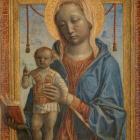Vincenzo Foppa, Madonna of the Book
Vincenzo Foppa, Madonna of the Book, tempera on wood, circa 1475 (inv. n. 305)
The huge legacy bequeathed to the City of Milan in 1863 by Antonio Guasconi included a small wooden panel painting known as the the Madonna of the Book, which became the symbol of the Art Gallery. This particular work was chosen to represent the Gallery because it is considered to be one of the most intense works ever painted by Vincenzo Foppa, the undisputed master of the Lombard Renaissance. The Madonna and Child emerge forcefully from an illusory space the realism of which is achieved by the exploitation of a false frame, an open book held at an oblique angle reinforces the effect of the scene. It is upon this geometrically accomplished structure that the artist directs the quality of his painting: the extremely personal choice of the silver-grey palette and the expressive intensity of the subjects is communicated by the touching expressions of the Madonna and the Infant Jesus who seems to anticipate his own destiny. The size of the painting betrays the original function of the work, which probably hung in a private space at eye height where the inscription in Latin on three sides of the frame could be more easily read. The verses, the first lines of a prayer centred on the immaculate conception, in accordance with the dogma professed by Pope Sixtus V, allows the work to be dated to no later than 1475.








